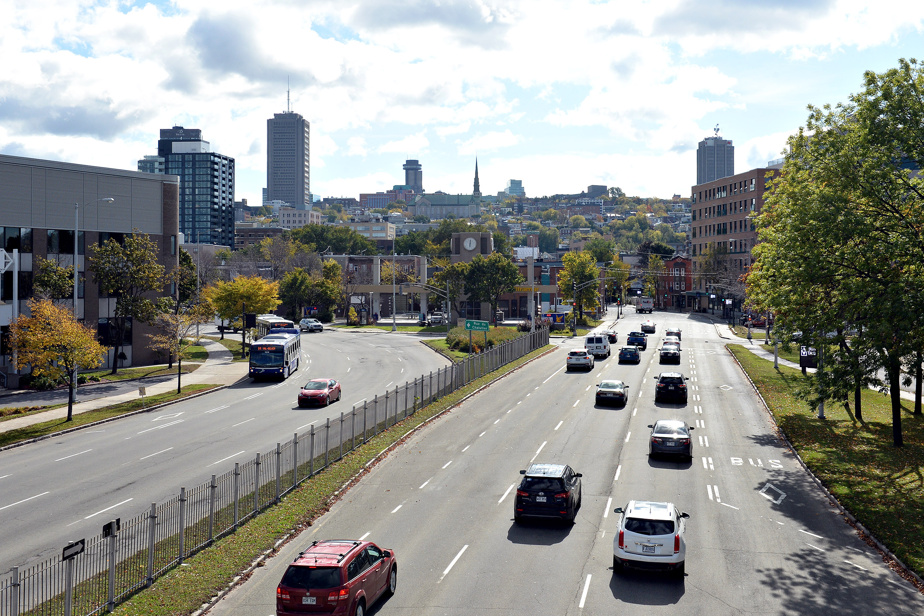(Quebec) The city of Quebec has an air quality problem that causes asthma in children and heart problems in adults, but regional public health has a prescription: reduce road capacity in a sensitive area of the capital.
This recommendation comes as the Legault government promises to build a highway tunnel between Lévis and Quebec. The third link must also come out near a sector of the city particularly affected by air quality problems and dump between 40,000 and 50,000 cars a day.
“The planning and transportation decisions we make now must be compatible with a decarbonized and clean future,” said Monday at a press conference the director of public health for the Capitale-Nationale, Dr.r Andre Dontigny.
Regional Public Health has unveiled a long-awaited report on air quality in Quebec’s Lower Town. It concludes that nickel is less dangerous for the local population than fine particle emissions.
“The concentrations of fine particles are comparable between Quebec and Montreal even if Quebec is a smaller city”, deplores the Dr Philippe Robert, public health doctor.
These fine particles are found everywhere in Quebec. There are even more in the Champigny area of Sainte-Foy than in Lower Town. However, these particles mainly come from wood heating and transportation.
Public Health therefore makes nine recommendations, including the reduction of road capacity in the Limoilou-Vanier-Basse-Ville sector and the promotion of public and active transportation.
“We must promote active transportation, a city with more pedestrians and bicycles,” said the Dr Dontigny.
The latter did not want to comment directly on the third link project. He promises to do so when he is submitted to the BAPE.
“But we give you here the parameters on which we will base ourselves to assess any project whatsoever, including a third link project,” he says. If the tunnel project generates “more volume in places where we want less volume, we will have to assess it on that basis”.
However, the tunnel that the CAQ government wants to build must come out near ExpoCité, in an area where the air quality is known to be poor.
Regional Public Health notes that the electrification of transport must improve air quality. But electric vehicles also emit fine particles, submits the Dr Philippe Robert, although studies do not yet agree on the quantity.
“In urban areas, several experts say that simply electrifying is not an optimal solution from a collective point of view. We do not have the same benefits as active transportation for public health. Even with public transport, studies show that people will walk, stand, less sedentary than when sitting in a car,” adds the doctor.
The solidarity deputy for Jean-Lesage, where Limoilou is located, also believes that this recommendation from Public Health “is one more nail in the coffin of the third link”. “The CAQ will have to choose between its third link and the health of the population,” noted Sol Zanetti in a statement to the media.
“The issue of air quality in Quebec is another argument for abandoning the third link project once and for all,” said PQ MP Joël Arseneau, his party’s spokesperson for environment.
Not unique to Limoilou
The report released Monday focused primarily on air quality in Limoilou-Vanier-Basse-Ville, located near the activities of the Port of Quebec. But Public Health estimates that the exposure of citizens to nickel poses “very low” risks and would cause “less than one case of cancer over 70 years” in the local population.
On the other hand, fine particles cause 20 cases of asthma among children in the area each year and 33 premature deaths from ischemic heart disease.
The measurements made by Public Health show that the Upper Town is not spared by fine particles. There are even more in the Champigny sector, and significant concentrations have also been noted near the Collège Saint-Charles-Garnier.
In all the sampling stations in Quebec, the concentrations of fine particles exceeded the standard of the World Health Organization.
“It is not a specific situation [à Limoilou]. Me, I would have no hesitation, I would go live there, ”said the Dr Phillip Robert.
According to him, the air quality in Quebec must be improved, but is similar to that of many urbanized areas. “But dense urban environments have several characteristics that we want, which are favorable to health,” he says, such as the ability to walk or ride a bicycle to get around.
The nine public health recommendations
- Accelerate the transition to sustainable mobility and reduce road capacity and traffic crossing the Limoilou-Vanier-Basse-Ville (LVBV) sector;
- Adopt improved regulations on wood heating in the municipalities of the Communauté métropolitaine de Québec (CMQ) and raise awareness;
- Increase greening and demineralization efforts in Quebec;
- Develop action plans to reduce emissions from heavy, maritime and rail transport, in particular through electrification.
- Intensify the reduction of polluting emissions from the industrial, commercial and institutional sectors;
- Continue efforts to reduce dust emitted by construction work, road traffic and industrial or port activities;
- Implement new mitigation measures at the source to avoid episodes of high daily nickel concentration in order to minimally comply with the current Quebec standard (70 ng/m3 over 24 hours);
- Consider setting up a governance mechanism at the scale of the Communauté métropolitaine de Québec (CMQ) to coordinate actions on air quality;
- Adopt intermediate targets in order to reach, in the long term, the guidelines issued by the World Health Organization (WHO).
